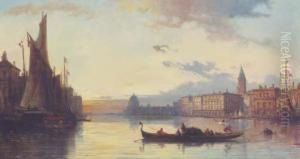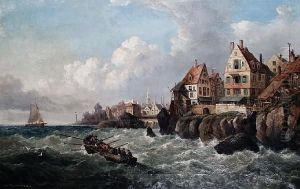Joseph Kuwasseg Carl Paintings
Joseph Kuwasseg Carl, born on October 27, 1833, in Draveil, France, was a distinguished French landscape painter, known for his mastery in capturing the essence of nature. He was the son of Charles Kuwasseg, a respected Austrian-born French artist, which provided him with an artistic environment from an early age. Joseph's initial training was under the guidance of his father, which laid a solid foundation for his artistic development.
Joseph's career was characterized by his fascination with landscapes, particularly maritime and river scenes, which were depicted with remarkable accuracy and a poetic sense of atmosphere. His work demonstrates a keen observation of natural light and color, which he skillfully translated onto canvas, capturing the transient moods of nature.
Throughout his lifetime, Kuwasseg participated in numerous exhibitions, notably the Paris Salon, where he first exhibited in 1859. His contributions to the Salon were met with critical acclaim, earning him recognition among his contemporaries and art enthusiasts alike. His paintings were celebrated for their detailed realism and vibrant portrayal of the French countryside and coastlines.
Kuwasseg's style evolved over the years, showing influences from the Barbizon school, which emphasized the beauty of the French landscape and the importance of painting en plein air (outdoors). However, he also maintained a distinct personal aesthetic, characterized by a meticulous approach to detail and a dedication to capturing the nuances of the natural world.
Joseph Kuwasseg Carl's legacy is preserved through his artworks, which continue to be admired for their technical skill and evocative portrayal of the landscape. His paintings are held in various public and private collections, serving as a testament to his contribution to the 19th-century French landscape painting tradition.
He passed away on April 27, 1904, leaving behind a body of work that continues to inspire and captivate art lovers around the world. Joseph Kuwasseg Carl's dedication to his craft and his ability to capture the essence of the French landscape have cemented his place in the history of art.













